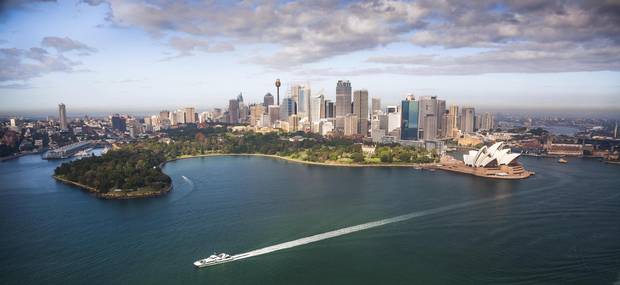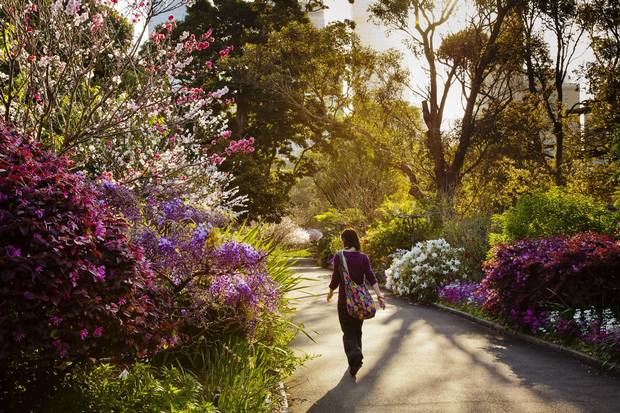
The Royal Botanic Gardens, established in 1816, juts into Sydney Harbour.
It's easy to miss the anchor, standing like an apologetic ancestral spirit amongst the gleaming glass tower blocks of 21st century Sydney. It stands on a stone pedestal in Macquarie Place, an oft-overlooked triangle of land near Sydney's Circular Quay.
"It belongs to the Sirius," says historian Mark Dunn, who runs the Making of Sydney walking tour. "One of the 11 ships in First Fleet that brought the original British settlers to Australia."
Sydney is not a place immediately associated with history and heritage. There's a harbour to cruise on, a bridge to climb, kangaroos to hand-feed in the zoo and beaches for bodysurfing. Dunn has something of a hard sell persuading people to spend three hours looking at remnant anchors and old buildings from the 19th century.
But there are plenty of incredible stories to dive into, and a lot of misconceptions about the early convicts being rogues and murderers to clear up.
The story of Australia's colonization is one of human history's most remarkable shots-in-the-dark. In 1770, Lieutenant James Cook charted the continent's hitherto unknown east coast. Eighteen years later, the First Fleet of 732 convicts arrived – thrown into an entirely alien land, about which they knew far less than we currently know about the moon. There were massive skill shortages, a heavy male to female imbalance and starvation quickly became a realistic prospect.

The Royal Botanic Gardens feature native plants, some with explanations of how aboriginal groups would use them for healing wounds.
Simone Cottrell
Dunn presses on through the Royal Botanic Gardens, where massive fig trees, impertinent cockatoos and chortling kookaburras share majestic harbour views. A Wollemi pine – a species only discovered in 1994 when a bushwalker went abseiling down a national park gorge – is planted in the centre as a reminder of how much of Australia remains unknown. Trails here lead around native plants, with explanations of how the local aboriginal groups would use them for healing wounds, making baskets and lighting fires.
But Dunn is taking us to a small replica farm, which is on the site of the colony's first attempts at agriculture. "They brought wheat, cabbages, eggplants, leeks and shallots with them," Dunn says. "Coffee and bananas, too. But they quickly discovered the soil wasn't suitable."
Farming quickly moved 26 kilometres west to Parramatta, where it was successful, and the original farm ended up being used as a nursery and testing ground for plants and trees, with the Botanic Gardens formally established in 1816.
This was during the era of Governor Lachlan Macquarie, a Scottish army man who left his mark on Sydney perhaps more than any other leader. This is partly because he really, really liked naming things in honour of himself, but mainly because he wanted to turn the colony into something more than a prison camp.
"Macquarie wanted to ensure survival through building and infrastructure," Dunn says as we pass the turreted, castle-like Conservatorium of Music on the edge of the Botanic Gardens. It was originally built as an improbably grand stable for the governor's house.
In 18th-century Britain, hundreds of offences – as trivial as stealing bread or poaching – warranted the death penalty. But judges, who were reluctant to put people to death for something so minor, were allowed to convert the penalty to transportation.
When the American Revolutionary War broke out in 1775, sending convicts across the Atlantic was no longer an option. British jails filled up as judges sentenced people to transportation regardless of there being nowhere to send them. So Cook's discovery on the other side of the world was suggested as one of the all-time great curveballs.
Macquarie knew that his bosses in London wanted the colony to strictly remain a place of punishment, and a deterrent to would-be criminals in Britain, so he had to employ a few sleights of hand. When building projects that could be seen as overly lavish – such as a castle for horses, perhaps – he'd simply not mention them until they were nearly completed.
He wasn't afraid to get innovative on funding, either. The Sydney Hospital is a grand, sprawling complex even by today's standards. The maze of courtyards and grandiose Victorian fountains on the grounds make it one of Sydney's most underrated strolls. At the time, though, it would have been comically outsized – and hugely expensive. Macquarie's solution? Offer three local businessmen a monopoly on rum importation in return for building the hospital.
The North Wing of the hospital was later turned into New South Wales Parliament House, and the grand sandstone buildings on the other side of Macquarie Street were put up as status-symbol residences by wealthy settlers.
A key factor in Macquarie's building spree was not what he was erecting, but who was designing it. The governor had a predilection for putting ex-convicts in positions of power. This won him many enemies, particularly amongst the free settlers. Most notable of these appointments was Francis Greenway, a convict who was transported for forgery, but given a chance as the colony's civil architect.
The city is peppered with Greenway's work, but the trio at the top of Hyde Park are the most significant.
The Hyde Park Barracks, built in 1819 and designed by ex-convict Francis Greenway, has been turned into a museum that harnesses both touchscreen technology and its historic setting.
ANDREW QUILTY/The New York Times
The St. James Church, Court House and Hyde Park Barracks form a complementary trio. All seem stout, yet lightened by architectural flourishes such as the brick arched windows. The barracks is the most rewarding to enter – it has been turned into a museum that harnesses both touchscreen technology and its historic setting. It tells tales of transportation conditions, conflict between governors and wool barons, poor Irish women being shipped out en masse to redress gender imbalance and catastrophic differences in attitudes toward property between the settlers and the indigenous local population.
By setting up key structures to last, Macquarie future-proofed his vision against regressive measures brought in by the governors who followed him.
The most potent symbol of this is back in Macquarie Place. There's an obelisk that is just as ignored as the anchor. On it, distances to inland towns in New South Wales such as Bathurst and Windsor are engraved. Before Macquarie arrived, these towns didn't exist – the exploration missions he commissioned paved the way for them. And the road network he built connecting these outposts made sure the colony expanded beyond one small settlement.
The obelisk is still the official centre of Sydney – all distances are measured from there. It's arguably where today's Australia begins, too.
Sydney is not a place immediately associated with history and heritage. But there are plenty of incredible stories to dive into.
iStock
IF YOU GO
Context Tours specializes in small group and private walking tours run by docents with strong expertise in their subject. The three-hour Making of Sydney walking tour runs with a minimum of three people and a maximum of six, $93 a person. Private tours from $420. contexttravel.com
Make sure to leave time to explore the museum inside the Hyde Park Barracks, which tells of early settlement, transportation and convict life. sydneylivingmuseums.com.au
Where to stay
The Old Clare Hotel has taken over a former brewery in the buzzy Chippendale area. The industrial chic rooms packed with original features and neighbourhood bar make it Sydney's hottest new hotel. Rooms cost from $266. theoldclarehotel.com.au
The writer was a guest of Context Tours. It did not review or approve the story.